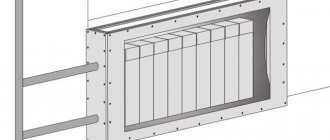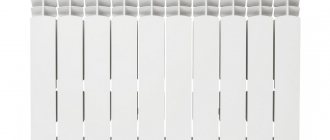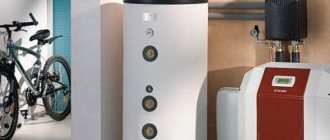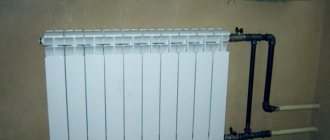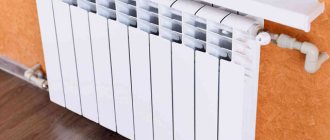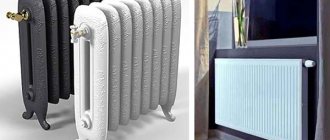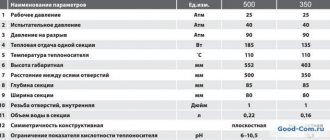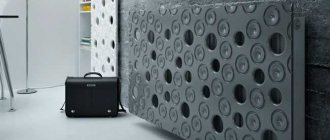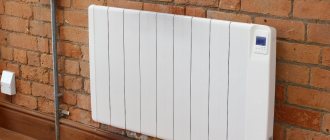In addition to keeping you warm, modern radiators have acquired unusual designs and colors. Heating devices have become, one might say, one of the starting points in interior design. Their vintage, modern or futuristic look can fit perfectly into the look of your home. The choice of styles and materials is large: from classic to minimalism, from aluminum to cast iron and stainless steel. And often heaters look like anything except radiators themselves. Let's start with the least exotic options.
Merging with the walls
Calculate the exact cost of repairs using an online calculator
and receive a free detailed estimate for repairs
Calculate
The radiator merging with the wall is still noticeable thanks to the copper fittings, but just enough to give the monochromatic interior a more strict outline.
Photo: bisque.co.uk
How to make an ordinary heater into a designer one with your own hands
Decorative heating sources are often made according to individual projects. Such devices are very expensive. But it is possible to turn a simple battery into an unusual designer product.
The easiest way to do this is to paint the device in its original color: blue, green, purple, maroon, brown. Also, by applying textured patterns, you can create an imitation of steel, wood and other materials.
Cast iron batteries are installed in ancient mansions and buildings from the beginning of the last century. Over time, they become unattractive, but they can be restored and made designer.
Restoration of a cast iron battery is carried out in three stages:
- cleaning the surface with sandpaper;
- application of the selected paint;
- complete drying.
Before starting work, you should turn off the heating, because the paint must dry naturally. If you have artistic skills, you can draw various ornaments on the battery, after first drawing the outlines with a pencil. Interesting patterns are obtained using gilding.
By the way, you need to select the most durable paints so that they do not change color when exposed to high temperatures. To decorate radiators, you can use ready-made stencils and stickers, which are attached using a special heat-resistant glue. At the last stage, the battery is coated with colorless varnish.
Cost of designer radiators of different types
Decorative heating devices are more expensive than conventional ones. The price is influenced by the dimensions of the product, material of manufacture and decorative features.
Cost of radiators made of different materials:
- Bimetallic will cost 2,700–15,000 rubles.
- Steel tubular radiator - 2700–44200 rubles.
- Glass device - 19,200–49,800 rubles.
- Designer battery made of cast iron - 6600–172100 rubles.
- A wooden battery can be bought for 23,500–46,900 rubles. Read the solid fuel boiler controller on our website.
Shapes and lines
If a designer decides to play with form, he does it masterfully. We are used to seeing hexagon tiles on the floor or on the wall in the bathroom, or, in extreme cases, as a backsplash in the kitchen. How do you like this radiator, made of voluminous hexagons? Too bright? Okay, choose calm lines in an interesting combination.
Photo: m.rouding.com
According to the material of manufacture
This is the main criterion by which radiators are classified.
Decorative models are made from various materials:
- become;
- aluminum;
- cast iron;
- metal;
- copper;
- glass;
- tree.
Steel
The distinctive features of steel tubular radiators are versatility, a wide variety of shades, sizes and connection types, unpretentiousness, low cost with good quality.
Such devices can operate in systems with operating pressures of up to 10 atmospheres, as well as in private homes. Fill with water or antifreeze. The production of tubular radiators is fully automated. They have all the advantages of premium designer batteries.
Prices for steel heating radiators
steel heating radiators
Aluminum
For the manufacture of aluminum radiators, two methods are used: casting and extrusion. In the first method, products are made from aluminum alloy with the addition of 12% silicon. This gives the radiator strength and allows you to preserve the thermal conductivity of the metal. The advantages of such devices are good heat transfer and efficiency.
Extrusion models are made in several stages:
- Horizontal collectors are cast.
- The main part of the body with fins is formed by extruding aluminum using an extruder.
- Then all the elements are connected by gluing, welding, and flaring.
As a result, the collector walls are much thinner, which reduces equipment weight, thermal output and operating pressure. The models are weakly resistant to water hammer, so it is not advisable to use them for centralized systems. However, they are perfect for installing individual heating.
Prices for aluminum heating radiators
aluminum heating radiators
Cast iron
Cast iron radiators are a timeless classic. Unlike the old Soviet “accordions”, modern cast iron batteries can have different designs, suitable for both palace and neoclassical interiors. They are also produced in various sizes and can be painted in different colors. Today, aged battery options are relevant.
Other advantages of cast iron heaters include:
- resistance to aggressive coolants;
- durability;
- high percentage of thermal radiation.
With the help of these devices you can create a truly cozy atmosphere in your home.
Bimetallic
Bimetallic radiators have a core made of steel or copper pipes and an aluminum body. This promotes efficient heat transfer. Hot water passes through the steel core, quickly heating the aluminum shell and the air in the room. Such devices are not subject to corrosion and can withstand pressures of up to 100 atmospheres.
Thanks to the material, the radiators are very light. The figured shell of the core and the intricate shape of the body look elegant and stylish.
Prices for bimetallic heating radiators
bimetallic heating radiators
Copper
The advantages of copper heaters are their attractive appearance, durability and resistance to corrosion. Another positive property of the products is environmental friendliness, since copper can prevent the reproduction and activity of various bacteria.
This metal is durable and reliable. With proper use and care, it will last up to 50 years. It is not afraid of aggressive low-quality coolant. Like gold and silver, copper has good thermal conductivity.
The disadvantages are: high cost and the need to use special equipment during installation.
Glass
Such a radiator, like any design device, serves not only for heating, but also for decorating the room.
The operating principle of glass heaters is as follows:
- The tempered glass panel is connected to the power supply;
- when heated, it transfers heat to the upper part of the device, which is made of decorative glass.
This type of radiator includes electric heating devices made from tempered glass. They look very nice.
Wooden
Wooden elements have always given the interior a feeling of comfort and peace. Radiators are practical, their service life is 30 years. The equipment is environmentally friendly, because natural wood of different species is used for production: makore, wenge, white ash, oak, maple, American walnut, beech, anegri.
Radiators have a moisture-resistant surface, they are easy to care for and wipe clean from dust and dirt. The front panel of some models, for example, the Loten brand, is easily removable, which allows you to wash the device.
In terms of aesthetics, wooden decorative heaters are much superior to conventional batteries. They can be made in various colors, including silver or gold.
Heating devices made of wood will fit perfectly into a city apartment decorated in eco-style, but they will look best in private houses made of logs or timber.
Abstract figures
If the great Salvador Dali could draw a clock sliding off a table, then why can’t a designer give a radiator the shape of a caterpillar divided into sections, or a rectangle consisting of cells? In these images, everyone will see something of their own, abstract or quite concrete.
Photo: decoist.com
How to choose the right one
Before you buy and install designer heating radiators in your apartment, you need to make a choice. Well-known companies today produce such heating devices: AEON, Arbonia, BREM, Broner, Cordivari, Demir, Dokum, Exemet, Fondital, Guratec, Hidria, Klima, Instal, Projekt, IRSAP, ISAN, Jaga, Kermi, MlniB, Purmo, RETROstyle , Runtal, SAVVA, Terma, Varmann, Viadrus, Zehnder, Rad Steel.
All of them offer quite decent products, which are sold in construction stores or branded heating equipment boutiques.
There are rules for choosing designer heaters that should not be neglected.
- Products must correspond to the general style of the premises.
- Important parameters are operating pressure and power, that is, heat transfer efficiency. They must ensure the normal functioning of devices in the heating system of the house.
- In terms of design and dimensions, the products must fit perfectly into the living space and provide good heat transfer.
- Designer batteries must have instructions indicating technical characteristics.
- The units must be free of defects.
- The threads at the connection points between the radiators and the pipe cannot be damaged.
The power of the heater depends on the type of building (panel, brick or wood), the number, area and thermal permeability of windows, the number of doors and walls. For example, for a standard apartment with a ceiling no higher than 3 m, a radiator with a power of 100–130 W/m2 is suitable.
Power characteristics should be increased if the following factors are present:
- two windows - you will need to increase heat transfer by 20%;
- closed front radiator panel with horizontal convection openings - by 15%;
- the presence of heavy multi-layer curtains - by 15%;
- elongated room configuration - by 10%.
Radiator-chain
You will not be able to dry towels on such a radiator. But there is something to surprise guests! In our opinion, such an object lacks brightness - the radiator almost merges with the wall and does not visually warm the bathroom. That would be nice!
Photo:

